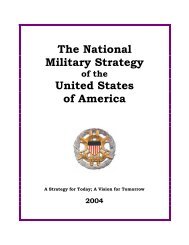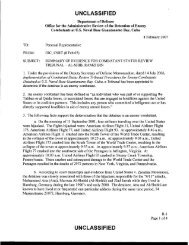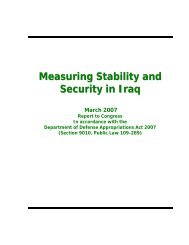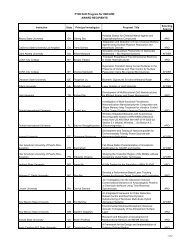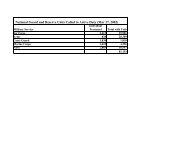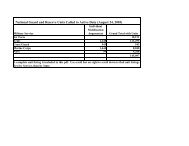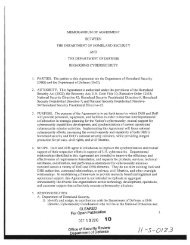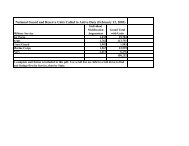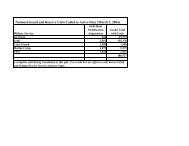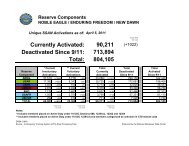Report - United States Department of Defense
Report - United States Department of Defense
Report - United States Department of Defense
You also want an ePaper? Increase the reach of your titles
YUMPU automatically turns print PDFs into web optimized ePapers that Google loves.
UNCLASSIFIED<br />
Figure 10: ANSF and ISAF Operations<br />
Operational Category Oct-12 Nov-12 Dec-12 Jan-13 Feb-13 Mar-13<br />
ISAF Unilateral Military Ops 1,852<br />
ISAF Unilateral Police Ops 0<br />
ISAF Led Unilateral Ops (Total) 1,435 1,124 1,252 1,320 1,848 1,852<br />
ANA Unilateral 18,768<br />
ANP Unilateral 11,966<br />
ANSF Led Unilateral (Total) 5,345 3,579 20,513 31,247 24,140 30,734<br />
ISAF Led Combined (ANA) 316<br />
ISAF Led Combined (ANP) 0<br />
ISAF Led Combined/Enabled Ops (Total) 1,962 1,537 1,676 1,814 2,282 316<br />
ANA Led Combined 956<br />
ANA Led Enabled 332<br />
ANA Led Combined/Enabled Ops (Total) 410 400 1,291 1,871 1,594 1,288<br />
ANP Led Combined 0<br />
ANP Led Enabled 183<br />
ANP Led Combined/Enabled Ops (Total) 183<br />
ANSF Led Combined/Enabled Ops (Total) 410 400 1,291 1,871 1,594 1,471<br />
Total Ops 9,152 6,640 24,732 36,252 29,864 34,373<br />
Total ISAF Led Ops 3,397 2,661 2,928 3,134 4,130 2,168<br />
Total ANSF Led Ops 5,755 3,979 21,804 33,118 25,734 32,205<br />
% <strong>of</strong> Total Ops that are ISAF Led 37% 40% 12% 9% 14% 6%<br />
% <strong>of</strong> Total Ops that are ANSF Led 63% 60% 88% 91% 86% 94%<br />
Oct-12 Nov-12 Dec-12 Jan-13 Feb-13 Mar-13<br />
Operation levels include Routine, Platoon/Toley, Kandak, and Above Kandak.<br />
Reference: IJC "ANSF in the Lead OPREP Roll-up," April 2013.<br />
Color scheme: Coalition is blue, ANP & ANA is green, combined is purple, and orange is summary statistics.<br />
Note 1: In December 2012 IJC issued a FRAGO requiring all forces to report more categories <strong>of</strong> operations; see rise in total ops in DEC 2012.<br />
Note 2: In March 2013 IJC began publishing these new operational permutations with greater specificity, e.g., ANA and ANP operations could be<br />
unliateral, enabled, or combined, and be either ANA/ANP led or ISAF led.<br />
GIRoA and ISAF made a deliberate decision several years ago to focus on the rapid growth <strong>of</strong><br />
the ANSF (force size), followed by the development <strong>of</strong> enablers and pr<strong>of</strong>essionalization <strong>of</strong> the<br />
ranks. This decision was made with a full understanding that the ANSF, once built to size,<br />
would need to develop logistics, personnel management, and leadership skills, among others.<br />
As such, the ANSF continues to require ISAF close air support, and airlift, logistics, medical and<br />
ISR support. The lack <strong>of</strong> these enablers prevents many ANSF units from reaching the highest<br />
capability rating.<br />
NTM-A’s emphasis for 2013 will be on measured growth, shaping both rank structure and skill<br />
sets to develop a capable and sustainable force. Most <strong>of</strong> the new units being fielded are now<br />
specialty units, such as counter-IED teams, which require more qualified recruits. NTM-A will<br />
not complete fielding <strong>of</strong> all organizational units until the end <strong>of</strong> 2013, and the AAF will not be<br />
fully fielded or mission capable until 2017. Once at full operational capability, the endstrength<br />
<strong>of</strong> both forces will be slightly below the total ceiling <strong>of</strong> 352,000 personnel. This will allow for<br />
natural fluctuations in attrition, recruiting and retention. 13<br />
13 These fluctuations are common in most armed forces, including the U.S. military.<br />
49



